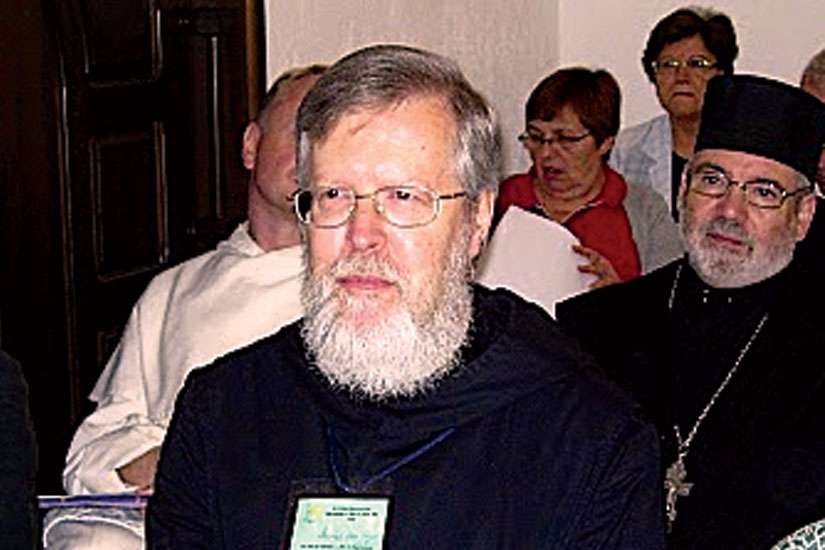In the Eastern Church, the penitential period that has prepared believers for the Easter celebration is called “Great Lent,” and its prayers invite the faithful to recognize their “need for forgiveness” and to “delight in the joy” of the fast.
Mother Theodora, the “hegumena” or abbess of the Byzantine Catholic Christ the Bridegroom Monastery in Burton, Ohio, describes the Lenten disposition as “bright sadness.”
“We recognize our weakness and sinfulness, but rejoice in the mercy of God,” she said.
Unlike Lent for Latin-rite Catholics, Great Lent did not begin on Ash Wednesday. It started after Forgiveness Vespers, which, for Eastern-rite Catholics, occurred on the Sunday before Ash Wednesday. During Forgiveness Vespers, the clergy and the congregation ask forgiveness of each other, one person at a time, for offences they committed, knowingly or not, and exchange a kiss of peace.
While all Catholics, East and West, are called to fasting, prayer and almsgiving during Lent, fasting and prayer are accentuated and lived more intensely in the Eastern Church.
Benedictine Father Michel Van Parys, abbot of the Byzantine-rite Abbey of St. Mary of Grottaferrata, outside of Rome, said the “dimension of spiritual warfare” and the belief in Jesus’ words that “some demons can only be cast out by prayer and fasting” are fundamental to Great Lent.
“The Great Fast is meant to be a challenge which brings out the real struggles of the spiritual life, so that they can be confronted,” said Mother Theodora.
In addition to “emptying ourselves in order to be filled with God,” the purpose of fasting is also “to discipline ourselves and to gain control of our passions,” she continued. “Fasting liberates us from worldly dependence and helps us to realize our dependence on God.”
The fast has spiritual and physical aspects. The spiritual “involves abstaining from evil thoughts, words and deeds,” she said. The physical fast traditionally includes eating less (or nothing at all during set periods) and abstaining from meat, fish with backbones, all dairy products, eggs, oil and wine for all of Great Lent.
However, fasting varies by degrees, depending on one’s state of health and type of work, said Van Parys. In addition, Eastern Catholics determine their fasting with their spiritual director, who accompanies them on their Lenten journey, he said.
Unlike in the West, fasting is “a cultural fact” in the Near East and in predominantly Orthodox countries, he noted. “There is some fear to fast (in the West). But you have to take small steps because fasting is not the goal in itself. It is opening your heart to God and to neighbour,” he said.
Stefano Parenti, a liturgy professor at the Pontifical University of St. Anselm in Rome, said, “at one time, fasting was also common in Western Christianity.” However, historical events, such as war, led Church leaders to grant dispensations from fasting.
“Then the war would end, but the dispensation would remain, so that dietary abstinence became perceived in the West as no longer characteristic of Lent,” he explained. Eventually, fasting and abstinence diminished in the West as a Church-wide practice and became personal. Today, Western Catholics can choose when to fast and from which foods to abstain, except for on Ash Wednesday and Good Friday, when fasting and abstinence are obligatory, and on the Fridays of Lent when they abstain from meat.
In the Byzantine Church, fasting is not individual but ecclesial, Parenti said. The entire Church fasts together and the food restrictions are set by the Church, offering a context that encourages growing in obedience and humility for one’s own good and the good of others, he said.
The communal aspect is emphasized in the liturgies and prayers found in a book called the Lenten Triodion, which accompany the faithful through Great Lent and explain the meaning of the fast, said Parenti. Prayer services and liturgies are longer and more frequent and the faithful are called to additional personal prayer at home.
The readings during Great Lent draw heavily from the Book of Genesis, highlighting the Lenten call to conversion, which requires a “going back to the beginning” and to a “state of harmony and peace with all creation,” said Parenti.
In the Byzantine Church, the fast also extends to the Eucharist, so that the liturgical sacrifice of the Eucharist is reserved only for Sundays. To emphasize the fast, the Liturgy of the Pre-Sanctified Gifts (comparable to a Communion service in the West) is held every Wednesday and Friday and the faithful receive the Eucharist that was consecrated on the previous Sunday.


